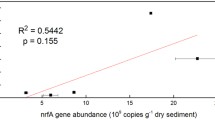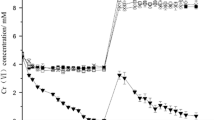Abstract
In this work, enzymatic and microbial degradation of organic matter in Lake Hongfeng, Guizhou Province, is described in terms of variations in DNA, α-glucosidase and sulfatereduction bacteria (SRB). Organic matter is degraded by microbes and extracellular enzymes excreted by the former, to a relatively low content below the 11-cm sediment depth. The distribution of DNA indicated that microbes are very active at the 9-cm sediment depth, where organic matter is degraded by microbes intensively. The contents of α-glucosidase are highest in suspend layer (0.75 μmol · min−1· g−1 dry sediments), showing that starch and hepatin in organic matter have been degraded intensively. α-glucosidase activity weakens with sediment depth. At the 11-cm depth where the degradation of organic matter started to slow down, α-glucosidase activity has been reduced to 0.17 μmol · min−1 · g−1 (dry sediment). Molecular biological research indicated that sulfate reduction bacteria (SRB) are distributed mainly at the upper 7-cm sediments in Lake Hongfeng. Combined with the results of research on the variations of organic matter and SO 2−4 , it is indicated that SO 2−4 is unlikely to become an important electron acceptor and sulfate reduction is not limited by the supply of organic matter in Lake Hongfeng.
Similar content being viewed by others
References
Alber, M. and I. Valiela, 1994, Biochemical composition of organic aggregates produced from marine macrophyte-derived dissolved organic matter [J]: Limnology and Oceanography, v. 39, n. 3, p. 717–723.
Alvarez, S. and M. C. Guerrero, 2000, Enzymatic activities associated with decomposition of particulate organic matter in two shallow ponds [J]: Soil Biology & Biochemistry, v. 32, p. 1941–1951.
Arthur, M. A., W. E. Dean, and K. Laarkamp, 1998, Organic carbon accumulation and preservation in surface sediments on the Peru margin [J]: Chemical Geology, v. 152, p. 213–286.
Boschker, H. T. S. and T. E. Cappenberg, 1998, Patterns of extracellular enzyme activities in littoral sediments of Lake Gooimeer, The Netherlands [J]: FEMS Microbiology Ecology, v. 25, p. 78–86.
Bottcher, M. E., H. Schale, B. Schnetger et al., 2000, Stable sulfur isotopes indicate net sulfate reduction in near-surface sediments of the deep Arabian Sea [J]: Deep-Sea Research II, v. 47, p. 2769–2783.
Burdige, D. J. and K. G. Gardner, 1998, Molecular weight distribution of dissolved organic carbon in marine sediment pore waters [J]: Marine Chemistry, v. 62, p. 45–64.
Canfield, D. E., 1994, Factors influencing organic carbon preservation in marine sediments [J]: Chemical Geology, v. 114, p. 315–329.
Coates, J. D., R. T. Anderson, J. C. Woodward et al., 1996, Anaerobic hydrocarbon degradation in petroleum-contaminated harbor sediments under sulfate-reduction and artificially imposed iron-reducing conditions [J]: Environmental Science & Technology, v. 30, p. 2784–2789.
Dauwe, B. and J. J. Middelburg, 1998, Amino acids and hexosamine as indicator of organic matter degradation state in North Sea sediments [J]: Limnology and Oceanography, v. 43, n. 5, p. 782–798.
Dauwe, B., J. J. Middelburg, P. M. J. Herman et al., 1999, Linking diagenetic alteration of amino acids and bulk organic matter reactivity [J]: Limnology and Oceanography, v. 44, p. 1809–1814.
Davey, K. E., R. R. Kirby, C. M. Turley et al., 2001, Depth variation of bacterial extracellular enzyme activity and population diversity in the northeastern North Atlantic Ocean [J]: Deep-Sea Research II, v. 48, p. 1003–1017.
Debosz K., P. H. Rasmussen, and A. R. Pedersen, 1999, Temporal variations in microbial biomass C and cellulolytic enzyme activity in arable soils; Effects of organic matter input [J]: Applied Soil Ecology, v. 13, p. 209–218.
Gerritise, R. G., 1999, Sulphur, organic carbon and iron relationships in estuarine and freshwater sediments: Effects of sedimentation rate [J]; Applied Geochemistry, v; 14, p. 41–52.
Hadas, O., R. Pinkas, N. Malinsky-Rushansky et al., 2001, Sulfate reduction in Lake Agmon, Israel [J]: The Science of the Total Environment, v. 266, p. 203–209.
Jorgensen, B. B., 1982, Mineralization of organic matter in the seabed-the role of sulphate reduction [J]: Nature, v. 296, p. 643–645.
Luckge, A., B. Horsfield, R. Iittkec et al., 2002, Organic matter preservation and sulfur uptake in sediments from the continental margin off Pakistan [J]: Organic Geochemistry, v. 33, p. 477–488.
Muller, A., 2002, Organic carbon burial rates, and carbon and sulfur relationships in coastal sediments of the southern Baltic Sea [J]: Applied Geochemistry, v. 17, p. 337–352.
Obernosterer, I. and G. J. Herndl, 2000, Differences in the optical and biological reactivity of the humic and nonhumic dissolved organic carbon component in two contrasting coastal marine environments [J]: Limnology and Oceanography, v. 45, n. 5, p. 1120–1129.
Portais, J. C. and A. M. Delort, 2002, Carbohydrate cycling in microorganisms; What can13C-NMR tell us? [J]: FEMS Microbiology Reviews, v. 26, p. 375–402.
Schubert, C. J., T. G. Ferdelman, and B. Strotmann, 2000, Organic matter composition and sulfate reduction rates in sediments off Chile [J]; Organic Geochemistry, v. 31, p. 351–361.
Shen Tong and Wang Jingyan, 1990, Biochemistry [M]; Beijing, High Education Publishing Company (the second edition), p. 10–43 (in Chinese).
Stepanauskas, R. and L. Leonardson, 1999, Bioavailability of wetland-derived DON to freshwater and marine bacterioplankton [J]; Limnology and Oceanography, v. 44, n. 6, p. 1477–1485.
Suzumura, M., K. Ishikawa, and H. Ogawa, 1998, Characterization of dissolved organic phosphorus in coastal seawater using ultrafiltration and phosphohydrolytic enzymes [J]: Limnology and Oceanography, v. 43, n. 7, p. 1553–1564.
Wang Guojiang, Bai Zhanguo, Wang Haoran et al., 2000, The geochemical records of C-N-P-S in recent sediments of Lake Erhai, China [J]; Geochimica, v. 29, p. 189–197 (in Chinese with English abstract).
Author information
Authors and Affiliations
Additional information
The research project was financially supported jointly by the National Natural Science Foundation of China (Nos. 40173038 and 40103007) and the Scientific and Technological Foundation of Guizhou Province (No. 20033054) and the Knowledge-Innovation Foundation of the Chinese Academy of Sciences (KZCX2-105).
Rights and permissions
About this article
Cite this article
Xiaobing, L., Jianming, Z., Congqiang, L. et al. Enzymatic and microbial degradation of organic matter in Lake Hongfeng, Guizhou Province, China. Chin. J. Geochem. 23, 81–88 (2004). https://doi.org/10.1007/BF02841140
Issue Date:
DOI: https://doi.org/10.1007/BF02841140




